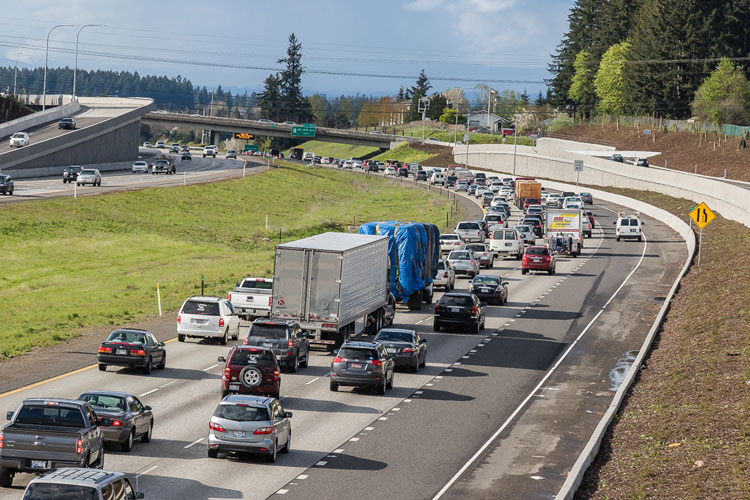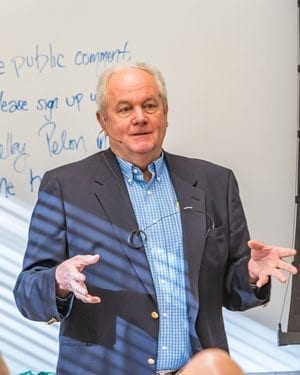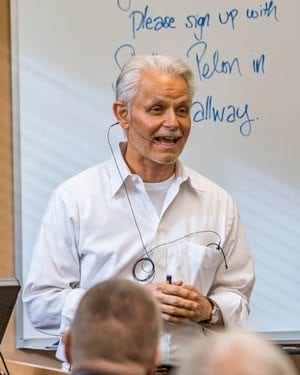
VANCOUVER — After Rep. Liz Pike’s third Transportation Congestion Solutions Legislative Town Hall had neared its end Saturday at Washington State University’s Dengerink Administration Building, Vancouver resident Phil Haggerty stepped to the microphone during the public comments portion of the meeting.
“I’m disappointed in our local politicians, other than Liz Pike and Vicki Kraft, who are not offering solutions other than fixing the existing (I-5) bridge,’’ Haggerty said. “They’re not going beyond that and they’re not listening to us.’’
The events of the past year have made the division over what to do about transportation congestion between the states of Washington and Oregon extremely clear. Pike, Kraft and a handful of other area elected officials are firmly of the belief that we need more ways to cross the Columbia River. Call them crossings, corridors or bridges, those elected officials want more of them and there is a significant amount of area residents who agree.

“We need new corridors, multiple corridors,’’ said Clark County resident Robert Schalk, who also spoke at Saturday’s town hall. “We need a westside bridge crossing. We need an eastside bridge crossing.’’
Each of Pike’s town hall meetings offered several presentations of varied solutions to the area’s transportation congestion issues. The proposals have included a new bridge to be built east of I-205, a westside crossing, and multiple ideas for the I-5 corridor including a flyover design that would also repair the existing I-5 bridge and a tunnel from Clark County to near the Rose Quarter in Oregon.
“My opinion is we need it all and we need more,’’ said area resident Kyle Nickels, who identified himself as a member of the trucking industry.
Washougal resident Julie Russell, a candidate for a position on the Washougal City Council, moved to Clark County from Tigard, OR, a couple of years ago. Russell and her husband still have offices in Tigard so they are forced to make the commute at least a couple of days each week.

“I wish our elected officials would have listened to you long ago, we wouldn’t be in this mess,’’ Russell told Pike and the panel of transportation experts the representative had assembled for the meeting. “I wish every one of our elected officials was required to make that drive so they knew what it was like. How do we get elected officials on board and change that paradigm that cars and additional lanes are evil.’’
Russell’s comments drew an enthusiastic round of applause from those in attendance at the meeting.
“Personal visits, eyeball to eyeball,’’ said Pike, answering Russell’s question. “As citizens, we need to remember you are in charge as citizens. It is all of our tax dollars that are going to fund any new infrastructure projects in our region. Elected officials work for us. We are their bosses. If we don’t weigh in and be vocal about our wishes on what we want for the future in our transportation, they’re going to do whatever they want and the planners who want to impose their worldview on how we move about, they’re going to do what they want.’’
David Nelson, a retired transportation engineer who has served as one of the presenters at all three of Pike’s town hall meetings, quickly relayed a story to illustrate what Pike referred to as planners who want to impose their worldview on how we move about.
“The Portland City Council had a hearing Wednesday or Thursday about the Rose Quarter expansion that was proposed — has been designed, been planned since 2012. Twenty-six groups got together to oppose the infrastructure. So, if your voice isn’t heard, they’re going to listen to them.’’
Like Nelson, Vancouver resident Bill Wagner has been a presenter at each of Pike’s three town halls.
“I’ve spoken not to groups, but to quite a few individuals — people in positions of influence in Oregon and some folks here in Vancouver,’’ Wagner said. “Ninety-eight percent of people realize we need additional corridors and they view the I-5 bridge as an additional step.’’

Despite that, Pike’s efforts in the state legislature (House Bill 1222) to form a bi-state bridge legislative work group failed earlier this year. Pike’s vision was that the work group would look at how to address the I-5 corridor but also research the need for additional corridors and other congestion issues. She wanted everything on the table.
Instead, both the House (HB 2095) and the Senate (SB 5806) passed companion bills, targeting the replacement of the I-5 bridge as a priority. Most who disagree with that majority of lawmakers see the effort as an attempt to resurrect the failed Columbia River Crossing. Those lawmakers seem to only want the one issue on the table.
“It’s amazing that the momentum in the Washington Legislature is still focused on the I-5 Bridge,’’ Wagner said. “I have to have faith that all of the multitudes out there with the common sense of regular folks is going to rise up and inform those in power, who are somewhat shortsighted, and they will open their eyes and look at the bigger picture as they fumble around with the I-5 Bridge. They were asked to look at corridors in addition to fixing the I-5 Bridge and we felt they shut us down. It is so shortsighted and unproductive what they are doing right now.’’
None of the elected officials from Clark County who supported the companion bills that passed the House and Senate attended any of Pike’s three town halls. Those lawmakers include Annette Cleveland (D-49th District), Ann Rivers (R-18th District) and Lynda Wilson (R-17th District) in the Senate and Reps. Paul Harris (R-17th District), Monica Stonier (D-49th District), Brandon Vick (R-18th District) and Sharon Wylie (D-49th District) in the House.
Those lawmakers did meet collectively last year in a process that resulted in their conviction to focus on the I-5 Bridge replacement but none have participated in a process as transparent and citizen-oriented as Pike.
Thankfully, one key lawmaker did attend Pike’s third town hall meeting — Rep. Ed Orcutt (R-Kalama), the ranking Republican on the House Transportation Committee, of which Pike has also been a member.
After Saturday’s town hall, Orcutt shared his thoughts with me about the challenge before lawmakers like himself and Pike.

“I’m trying to work with people; I’m trying to ease some people into some things,’’ Orcutt said. “When I compare Clark County to Cowlitz County, there are five crossings across the Cowlitz River with eight lanes in each direction for a population of 100,000 people.
“You’ve got 450,000 people in Clark County and you’ve got seven lanes in each direction across the Columbia River,’’ Orcutt said. “When you factor in all the population on the other side (Oregon) and all the goods and stuff were trying to get across the river, it just doesn’t work. It’s obvious it’s not going to work. How can Cowlitz have eight lanes (each direction) and Clark County only have seven (over the Columbia River)? We’ve got to have more lanes than that down here to make it work. It’s absolutely absurd to me that we haven’t done that.’’
I shared with Orcutt that it appeared to me there was little hope for an about face among lawmakers in the state of Washington. What gives him hope that elected officials like he and Pike will have any success in the future?
“I’m trying to help people understand why there are additional corridors necessary and that we’re not going to solve this problem without additional corridors,’’ Orcutt said. “I’m trying to get people to look at it not as either fix the I-5 Bridge or do a third crossing. I’m trying to get people to look at that is a functionally obsolete bridge. You’ve got a poor alignment getting on to it, narrow lanes, no shoulders and you have a short sight distance. It needs to be replaced. We need a more modern bridge.
“But, just making it a modern bridge is not going to solve the congestion problems,’’ Orcutt said. “We need to be looking at a third bridge too. We need to be looking at the safety issue, a variety of issues with that (I-5) bridge. But, we also need to look at the bigger issue of getting traffic flowing in both directions across the (Columbia) river.
“I think we have a chance to do both,’’ Orcutt said. “There’s probably $10 billion in projects going on right now in the Puget Sound region. You’re telling me we can’t do a $2 or $3 billion project between two states upgrading one bridge (I-5) to a newer, modern bridge and adding a third bridge? I think we can do both as a package. I think that’s our best hope for getting some real congestion relief and actually getting people moving across the Columbia River.’’




